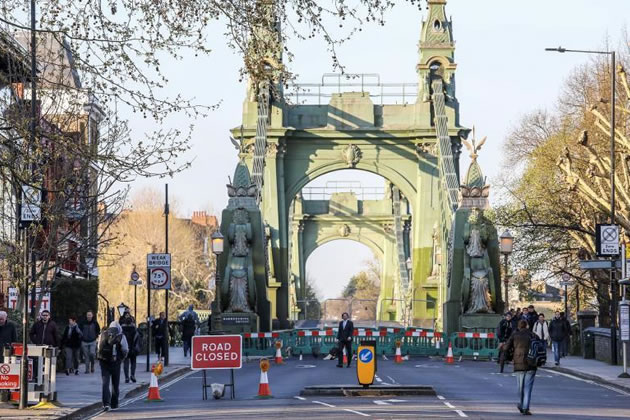Six and a Half Years To Reopen Hammersmith Bridge
Task force meeting hears toll might be needed to fund repair

Hammersmith Bridge will not be able to open to traffic for six and a half years, and a toll could be imposed to make it financially viable.
The revelations were made at last Wednesday night’s (October 28) first public meeting of the task force set up by the Department for Transport last month to find solutions to reopening the bridge.
One of the key issues is the state of the four pedestals that help to hold up the bridge – all of them have cracks in.
A crack growing in one of the pedestals triggered the complete closure of the bridge this summer.
Dana Skelley, project director at the task force, said the bridge will need to undergo emergency stabilisation, then permanent stabilisation, and eventually strengthening before it can fully reopen.
She said the first stage of the project would be to start a ferry contract to allow people to cross the river.
This is expected to take 66 working days to start after funding is released – and it is hoped a service will start in spring next year.
She said it will then take four months to understand the condition of all the pedestals – and it is possible that there could be a controlled opening to pedestrians and cyclists subject to a risk assessment.
She said emergency stabilisation work would then take place – taking seven months and costing £13.9 million. It would be followed by permanent stabilisation work which would take a further 21 months and cost £32 million.
Lastly the bridge would need to be strengthened to allow cars and buses over it again. This would take another 30 months and cost £80 million.
The thorny issue of funding such an expensive project soon reared its head.
Cllr Sue Fennimore, from Hammersmith and Fulham Council, told the meeting that alongside Transport for London they had made two applications to the Department for Transport this year, and one to the Ministry of Housing, Communities and Local Government for Hammersmith Bridge as part of “shovel ready projects” that needed funding, but all were rejected or not replied to.
She argued that funding is the “critical point” in reopening the bridge and the borough is not in a position to fund the extraordinary work needed.
Recording of Task Force meeting
Heidi Alexander, Deputy Mayor for Transport, echoed her concerns and said coronavirus had “devastated” TfL’s finances.
However, she insisted that TfL will do all it can to get the bridge back open and said the task force would have failed residents if people can’t walk and cycle across the bridge by this time next year.
Baroness Charlotte Vere, from the Department for Transport, who is spearheading the task force, argued that the government does not own the bridge and that improvements and maintenance are the legal responsibility of the owner – in this case Hammersmith and Fulham council.
However, she did agree that the bridge is “exceptional” and the Government does have a role to play and will provide funding to get the package put together.
This was welcomed by the Deputy Mayor, however, she made it clear that London councils do not have “tens of millions of pounds lying around” for works such as this.
She added, “I know this might not be music to people’s ears on this call, but I do wonder whether some form of toll may be required in future in order to enable the council to borrow against future toll income.”
She said there would need to be discussions on how much this would be, and whether there would be residents’ exemptions or discounts, and to what extent this would have an impact on traffic on the wider transport network.
“I recognise that if we’re going to find a solution to funding this bridge then we need to look at all options,” she said.
She also asked the Government to consider front-loading its contribution to start the procurement on the first stage of works.
Baroness Vere said she would look at this but would need to be assured that an agreement is reached on the entire project.
She said she was concerned emergency work will happen and then no further work will follow.
Sian Bayley - Local Democracy Reporter
October 29, 2020